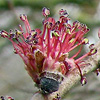Ulmus minor (Field Elm) is a deciduous tree of the Ulmaceae family. It can reach a height of up to 12 m, and the diameter of its crown may reach 10 m. Its leaves are similar to those of its relative, the Celtis. They are asymmetrical, and the midvein divides them into two unequal parts, especially at their base. The veins are prominent, the leaves are alternate. The leaf is ovate, acuminate, with a length of up to 10 cm. Its margin is coarsely dentate. The leaf is very pilose when young, and becomes glabrous as it matures. The trunk is erect and straight, brown gray. The bark is smooth when young, becomes scabrous as it matures and turns a dark brown.
Field elm blooms in February-March, while the tree is still exfoliated. The bloom is abundant but not prominent, because the flower is tiny (with a diameter of 3 mm) and lacks a corolla. It is bisexual, lacks nectar, and is pollinated by wind. It is yellow-green, its stamens are prominent, and reddish in color. The fruit is a round scarious samara and is as flat as a leaf, up to 15 mm long – contrary to its relative the Celtis, whose fruit is spherical. The fruit grows before the sprouting of the leaves and is green when young, when the fruits look as if they were the tree’s leaves.
Field elm is rare in Israel. It grows on the banks of rivers with flowing water all year, around the Hula Valley, in the Galilee, Samaria and on Mount Carmel. Israel comprises the southern boundary of its global distribution, which spreads around the countries to the north of the Mediterranean Sea.
The tree is customarily used as a fast-growing ornamental tree. The wood is good for creating handles for tools, for frame-heads, furniture, boats and coffins.
The genus contains 45 species.
Written by Mike Livne





